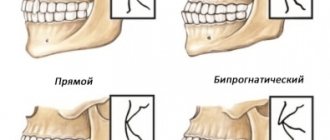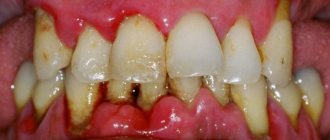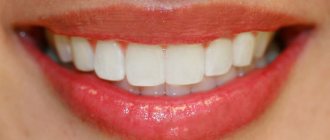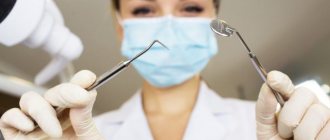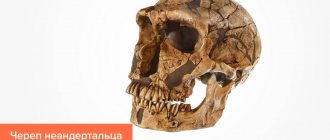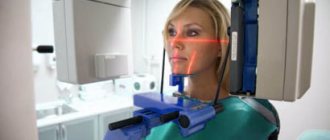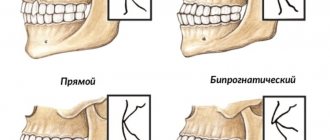Signs that make it easy to determine a person’s character by their teeth
Shape of teeth
says a lot about a person, and you can determine
the type of person by his teeth
by paying attention to the following signs of the dentition:
Upper incisors
| People with long incisors They are usually the life of the party, but at the same time they persistently strive for their goals and are quite open in communicating with others. Large incisors most often occur in adamant, stubborn people who persistently pursue their goal. Despite their difficult nature, those with large teeth are distinguished by their sincerity. Large gap between teeth betrays the explosive nature of their owner. In addition, the hole indicates an addiction to risk, which is not always justified. |
Fangs
It is generally accepted that large, sharp teeth
, including fangs, speak of a person’s aggressiveness. In fact, this is not always the case. In most cases, such teeth reveal a loving person. They can also talk about determination.
For example, if a woman’s upper canines are large and long
, then this can emphasize her kindness and humor.
Evenness of teeth
| A person's character can be determined by the curvature or straightness of their teeth. Ideal dentition speaks of a balanced, calm character. Such people are not afraid to make decisions and take responsibility. They are eloquent, self-confident and ready to go towards their goal no matter what. Uneven teeth speaks of the good intuition of the owner of the teeth. |
A person’s small, fox-like teeth can also tell about a person’s character.
— owners of such dentition are often characterized by lust.
Protruding teeth
characteristic of stingy people.
Teeth size
Strong large teeth
testify to a person’s courage, strength and kindness. Such people are most often long-livers.
| They will tell you what character the girl has and small teeth - often their owners are quite secretive and reserved natures. They have a small number of friends. Often people around them simply do not understand them, considering them strange. What do sparse teeth a person does not need to think for long - such teeth indicate people with a wild imagination, who always have a fresh, interesting idea in their heads: they can often even be considered strange. They are also distinguished by their tenacity of character and always go towards their goal. |
Small teeth
, among other things, can talk about greed. Such people have a hard time parting with money and are certainly not ready to spend it on others, be it relatives or friends.
Presence of damage
The presence of damage to the dentition can also indicate the character of a person
So, if
the upper row of teeth is damaged
, this will indicate difficulties in unlocking your potential, and if there are
problems in the lower part (especially in the left)
, you should think about problems in family relationships.
How can fangs interfere?
Many people, for various reasons, dream of getting rid of fangs. The reason for this can be both aesthetic and more serious interference caused by teeth. Incorrect development of canines can lead to malocclusion; their too large size oppresses neighboring teeth, preventing them from developing correctly and often contributing to their crooked growth. There are frequent cases of fangs appearing on a person’s gums: in this case, they hang over the rest of the jaw, disrupting the external attractiveness of the dentition, and thereby annoying their owner.
General concepts about teeth and their classification
Teeth are special bone formations that carry out the primary mechanical processing of food. People have long been accustomed to eating rather tough foods - meat, grains, plant fruits. This food requires considerable effort to process, and therefore healthy teeth have always been considered an indicator that a person eats a varied and good diet.
To begin with, what you need to know about teeth is that they are the only organs in the human body that cannot be restored . Both their apparent reliability and fundamental nature are quickly violated by bad habits and poor care.
And if milk, primary teeth are fragile precisely because of their temporary purpose, then the molars are given to a person for the rest of his life. In general, the entire dentition in a person is divided into the following types:
- fangs;
- incisors (lateral and central, also called lateral and medial);
- molars or large molars (this also includes the upper and lower wisdom teeth that grow in a person in adulthood or young age);
- premolars or small molars.
As a rule, the location of the dentition on the upper and lower jaw is recorded using the so-called dental formula . For molars and milk teeth, this formula differs only in that the molars are most often designated using Arabic numerals, and the milk teeth - with Latin numerals.
For an average adult, the dental formula looks something like this: 87654321|12345678. The numbers indicate teeth - any healthy person must have one canine, 2 incisors, 3 molars on each side, 2 premolars on the upper and lower jaw. As a result, the total quantity is 32 pieces .
For babies who have not yet had their primary teeth replaced, this formula looks different, since there may be about 20 . As a rule, temporary teeth erupt by 2–3 years of age, and by 9–12 years they are completely replaced by permanent teeth. However, not all people can boast of having all 32 sprouted teeth.
Since wisdom teeth or third molars can appear in adulthood, or they can remain completely in their infancy all their lives, in which case a person will have 28 teeth . Moreover, the structure of the lower and upper jaws has certain differences.
On a note
You should not go to extremes and see any toothache as a serious disease of the internal organs. It could be ordinary caries and nothing more. After all, the cause of caries can be many different or a combination of several factors: past infectious diseases, stress, lack of microelements, metabolic disorders.
During inflammatory processes in the teeth (caries, pulpitis), pain appears so acute that the person immediately grabs the pills and the pain goes away. It turns out that the signal from the diseased organ was never noticed. And the process of destruction does not slow down, foci of chronic infection arise, which can be a source of more serious disorders in the body (sometimes this can even result in a heart attack, meningitis, sinusitis). In order for the body to work smoothly, you need to contact the dentist in a timely manner. And at the same time, we should not forget that after treating a diseased tooth, it is advisable to examine the organs associated with it.
Source
Why are teeth in the wrong position?
Three main reasons:
Teeth may naturally be large, but the jawbone may be small. If the teeth do not have enough space in the row, they erupt, protruding forward or backward (in this case, those teeth that erupted earlier appear to be protruding). If the space for a tooth is severely narrowed, it may not grow fully (have insufficient crown height) or may not appear at all. Such a tooth, which is in its infancy, is called impacted. It can be seen on a CT scan.
Fangs erupt at 9–12 years of age. The later, the greater the likelihood that they will be positioned incorrectly.
If by the time of teething a malocclusion has already been formed, then the teeth will tend to occlude correctly, even if they are uneven relative to each other.
If baby teeth are not properly cared for and caries are not treated, they may fall out prematurely. The space in the row of teeth will be reduced, because in childhood all tissues are elastic, and the teeth always tend to close if gaps appear. Permanent teeth may begin to erupt in the wrong direction.
Those who have protruding canines often have large teeth themselves. Therefore, after treatment by an orthodontist, the smile looks very attractive.
Often there is simply not enough space for fangs
In what cases do the fangs protrude forward?
This is one of the most common disorders that orthodontists work with. It's all a matter of teething order. The upper teeth, each of which has a serial number, appear as follows: 1st incisor, 2nd incisor, 1st premolar, canine. That is, the canine, which occupies a place near the lateral incisor, must grow in the space that remains after the eruption of the premolar. If there is not enough space, then the tooth cannot stand straight.
This is the order in which the permanent upper teeth grow.
Human fangs: how to remove them?
- The easiest and shortest way is grinding. In this procedure, the protruding ends of the teeth will be removed and shortened. The doctor will cover the top of the tooth with special enamel. Among the advantages of the method are speed and painlessness. Among the disadvantages is that sharp edges will remain in any case, and you will have to get used to them - and incorrect development of the bite is not excluded.
- The highest quality alternative with virtually no negative consequences is orthodontic treatment with braces. This is especially recommended for teenagers under 18 years of age - at this age the jaw is not yet fully formed, and many things can be corrected in the shortest possible time. For adults, this process takes much longer (the system can be worn for up to two years), and is not always possible - a specialist can advise you more precisely.
- In addition, there are other, very effective methods for correcting fangs. This includes surgery, laser correction and more. Often such treatment is more expensive, but much less time will be spent on it than on correction with braces.
Of course, there are situations when removal of the fang is the only way out - for example, if it is severely damaged. However, any doctor will try to do everything possible to save your teeth. If the presence of fangs confuses you from a visual point of view, you will probably be interested in the fact that special fang extensions are very common among young people. Many consider this feature original and strive to highlight it. So you just have to reconsider your attitude towards this feature - and the intervention of a doctor will not be required at all.
Anatomical structure
The anatomy of a human tooth suggests that it is conventionally divided into 3 parts: root, neck and crown. The crown is the part that rises above the gum; it is covered with enamel - the strongest tissue that protects the tooth bone from the negative effects of acids and bacteria. There are several types of crown surfaces:
- The facial is the surface on the side of the lip or cheek.
- Occlusion is the surface in the area of closure with a paired tooth, which is located on the opposite jaw.
- Contact - the surface of the crown, which faces the teeth located in the neighborhood.
- Lingual – internal part. It faces the inside of the oral cavity, that is, the surface that the tongue touches during conversation.
The neck is the part that is located between the root and the crown , connecting them, covered with cement and closed by the edges of the gums. The root is the part with which the tooth is attached to its socket. Taking into account the classification type, the root can have one or more processes.
Histology
The histological structure of all teeth is exactly the same, but all of them have a different shape, taking into account the specific function they perform.
Enamel. It is a durable fabric that consists of 95% of various salts such as zinc, magnesium, copper, strontium, fluorine and iron. And 5% consists of substances such as carbohydrates, lipids, proteins. In addition, the enamel contains a liquid that participates in physiological processes.
At the same time, the enamel also has an outer shell , which is called the cuticle; it covers the chewing surface, but over time the cuticle tends to wear off and become thinner.
The basis of the bone tissue of the tooth is dentin - a set of minerals surrounding the root canal and the entire dental cavity. Dentin tissue contains a large number of tiny channels through which metabolic processes take place and nerve impulses are also transmitted through the channels.
Root structure: pulp and periodontium
The cavity inside the tooth is formed by the pulp - this is a loose and soft tissue, penetrated through and through by nerve endings, as well as lymphatic and blood vessels.
The structure of the roots looks like this. The root is located in a special hole - the alveolus , in the bone tissue of the jaw. The root, like the crown, consists of mineral tissue - dentin, covered on the outside with cement.
The root ends with an apex , through its opening blood vessels pass that feed the dental bone. The number of roots can vary depending on the functional purpose of the teeth, from 1 root in the incisors to 5 in the chewing teeth.
Periodontium is the connective tissue that fills the gap between the jaw socket and the tooth root. The fibers of the tissue, on the one hand, are woven into the cement of the root, and on the other, into the tissue of the jaw bone, due to this the tooth is firmly attached. In addition, through the periodontal tissue, the feeding elements of the blood vessels can enter the dental tissue.
General conditions
Existing or past diseases manifest themselves in the form of various inflammations and diseases of the oral cavity, teeth and gums.
- If in childhood you suffered from severe flu or measles, then in adulthood this can result in diseases of the periodontium (periodontitis, periodontal disease) and teeth (pulpitis).
- If your body suffers from a lack of water or it is difficult to remove it from the body, do not be surprised by bleeding and gum inflammation.
- Vitamin deficiencies, especially a lack of vitamin C, are the cause of loosening and even tooth loss.
- Diseases of the gastrointestinal tract manifest themselves in the form of a whitish coating on the tongue, cracks and inflammation of the tongue.
Why are they needed?
This article talks about typical ways to solve your issues, but each case is unique! If you want to find out from me how to solve your particular problem, ask your question. It's fast and free
!
The main function of the fangs is to tear apart solid food. Due to their structure, these teeth can withstand increased loads that the front incisors cannot. However, the diet of modern people has changed significantly compared to antiquity, so some scientists consider fangs as a vestige. Indeed, we rarely have to bite off pieces of raw meat, so the load on these teeth is small.
Nevertheless, the fangs have retained their structure: on the inside of the crown there is a groove that divides it into two unequal parts. A tubercle stands out on the cutting edge, due to which the tooth has a cone-shaped shape, similar to the teeth of predators.
Some experts express the opinion that relatively soon a person will lose his fangs due to the fact that their functions are not fully used. Whether this is true or not, time will tell, but you need to keep in mind that they also serve as a supporting frame for the facial muscle. When these teeth are removed, the cheeks may sag. In addition, they also affect diction, so their vestigiality is a rather controversial issue.
Description of the dentition
Incisor teeth. The human jaw is symmetrical and contains the same number of teeth of each type. But there are certain anatomical features of the upper and lower jaw. Let's look at them in more detail.
Incisors are the front teeth . A person has eight of them - 4 at the bottom and 4 at the top. Incisors are needed to bite food and separate it into parts. The peculiarity of the structure of the incisors is that they have a flat, chisel-shaped crown with rather sharp edges.
On anatomical sections there are three tubercles, which are erased throughout life. On the top of the jaw there are two central incisors - the largest of all the incisors in their group. The lateral incisors are similar in shape to the central ones, but smaller in size.
What is noteworthy is that the immediate cutting edge of the lateral incisor also has three tubercles, and often takes on a convex shape as a result of the development of the central tubercle. The root of the incisor takes the shape of a cone, and is flat and single. A distinctive feature of the incisor is that on the side of the tooth cavity there are three pulp tips corresponding to the tubercles of the cutting edge.
The anatomy of the upper teeth is slightly different from the structure of the lower dentition, so in the lower jaw everything is exactly the opposite. The middle incisors are smaller , unlike the lateral ones, and have a shorter and thinner root than the lateral incisors. The outer surface of the cutter is slightly convex, while the inner surface is concave.
The crown of the incisor is curved from the side towards the lips and is very narrow. The cutting edge has 2 angles - in the center, more acute, and inside - more obtuse. The roots have longitudinal grooves.
Chewing teeth and fangs
Fangs are used to break down food into smaller pieces. The anatomy of the fangs is such that there is a groove on the inside of the crown; it disproportionately divides the crown into 2 parts. The cutting edge of the fangs has one pronounced and developed tubercle, this makes the cone-shaped crown often similar to the fangs of a predator.
The canine on the lower jaw is narrower in shape, the ends of the crown are concentrated in the medial tubercle. The canine root is flat, inclined inward and the longest, unlike the roots of other teeth. A person has 2 fangs on both jaws . The lateral incisors with the canines form an arch, where the transition from the incisors to the chewing teeth begins in the corner.
Let us consider the structure of the small chewing tooth first, and then the large chewing tooth. Their main task is thorough processing of food . This function is performed by molars and premolars.
The first premolar (No. 4 in the dental formula) differs from the incisors and canines in its prismatic shape, and there are convex surfaces on the crown. The surface has 2 tubercles - lingual and buccal, with grooves between them.
The buccal tubercle is much larger in size than the lingual one. The root of the first premolar has a flat shape , but with a slight bifurcation into the lingual and buccal parts.
The second premolar is similar in structure to the first, but its buccal surface is much larger, and the root has a compressed anteroposterior direction and a conical shape . In the first lower premolar, the chewing surface is inclined towards the tongue.
The second premolar is larger than the first due to the fact that both tubercles are symmetrical and equally developed, and the depressions in the enamel between them have the shape of a horseshoe. The root is the same as that of the first premolar. has 8 premolars in the dentition , four on each side (on the lower and upper jaws).
In the upper jaw, the first molar is the largest. Its crown is similar to a rectangle, and the chewing surface is diamond-shaped with 4 tubercles. This molar has three roots: one straight - the most powerful, and two buccal - flat, deflected in the posterior direction.
During the closure of the jaws, the first molars rest against each other and form a kind of “limiter ”; because of this, they undergo significant loads throughout a person’s life.
The second molar is smaller . The roots are the same as those of the first molar. The structure completely coincides with the location of the premolars described above.
On the lower jaw, the first molar for chewing food has five cusps. This molar has two roots - the anterior one with two canals, the posterior one with one. In this case, the anterior root is larger than the posterior one. In the lower jaw, the second molar is similar in structure to the first. The number of molars in humans is the same as the number of premolars.
The third molar is called a “ wisdom tooth ,” and a person has four of them in the dentition, two on each jaw. On the jaw below, the third molar has many variations in cusp development. As a rule, there are five of them. And, in general, in a person the structure of a “wisdom tooth” is the same as the structure of a second molar, but the root usually resembles a very powerful and short trunk.
Or maybe it's easier to remove?
Sometimes healthy teeth have to be removed to correct a malocclusion, and most often it is the canines that receive this sentence. But if you can do without extraction (in most cases you can), of course, it is better to save all the teeth: they are important both for chewing and for supporting the soft tissues of the face.
Today, there are no unsolvable problems for an orthodontist: by combining the effects of braces and various auxiliary devices, the doctor can correct any deficiency. With us, treatment is simple, convenient and affordable. To find out everything about treatment in installments, as well as to make an appointment, call us at +7 (812) 575-56-01.
Do you want a beautiful smile, but live in another city? Get treatment from top dentists in St. Petersburg. We will create a plan for you online absolutely free! We are waiting for you at our clinic. Write to us!
Source
